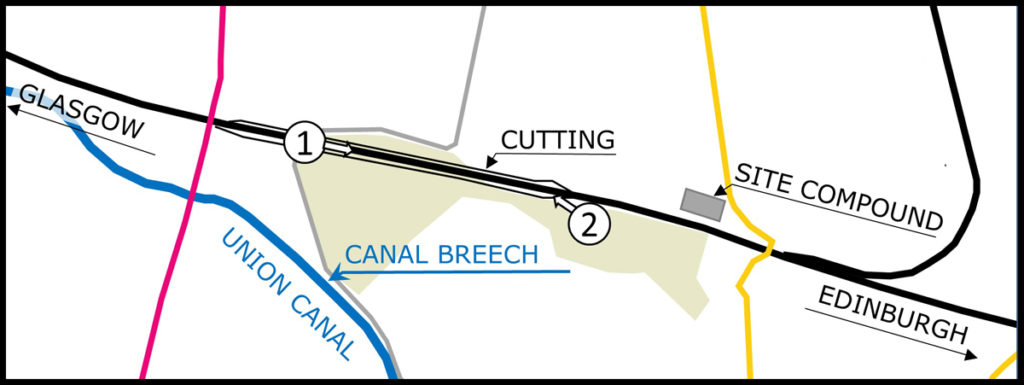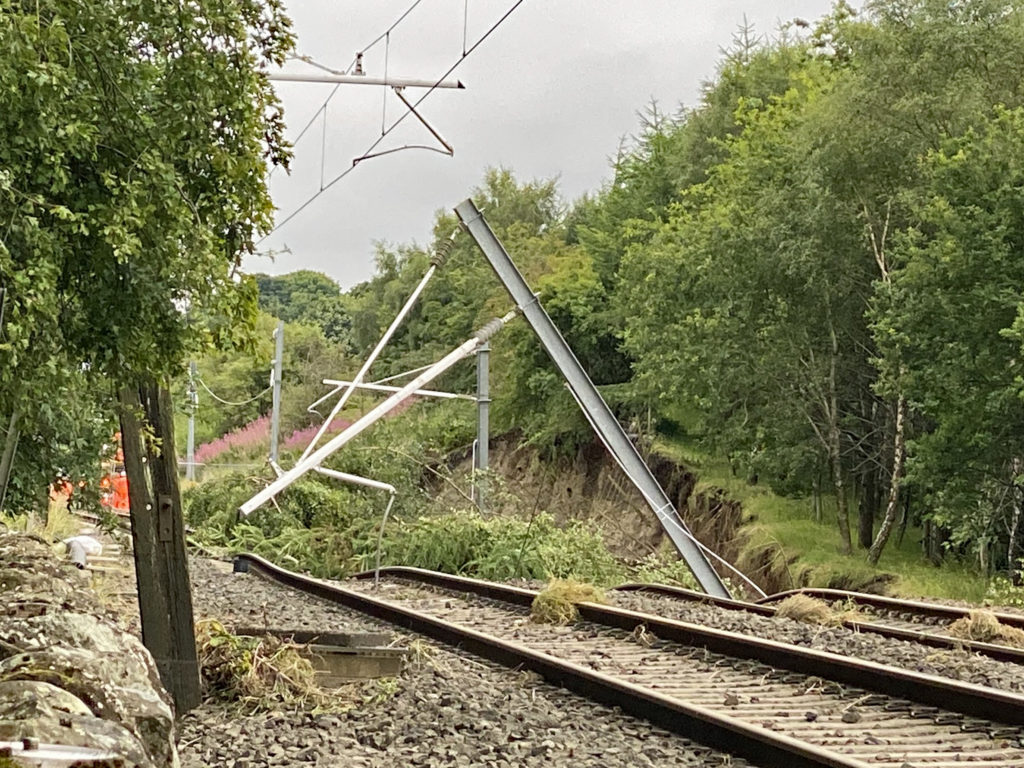The severe weather on the night of 11/12 August, that led to the tragic derailment outside Stonehaven, also caused far greater infrastructure damage on the Edinburgh to Glasgow main line between Polmont and Linlithgow. This also had the potential for derailment
However, in this case, there was nothing that Network Rail could have done to prevent the damage, which was caused by massive flooding from the adjacent Union Canal. Due to the amount of rain that had fallen, the canal overflowed its banks, opening up a 30 metre-breach of the canal embankment and allowing a huge volume of water to flood the surrounding area.

The Union Canal, which opened in 1822, is a 32-mile long contour canal between Edinburgh and Falkirk and thus has no locks to stop the flow of water along it. The breach occurred early in the morning. Realtime trains shows that the 05:03 Edinburgh to Glasgow train was the only one to run on the line on the 12 August, thereafter, all trains were cancelled.
By late morning, Scottish Canals placed stop-planks in position to reduce the flow. The planks at Linlithgow were six kilometres from the breach and the water level of the canal there had already fallen by about half a metre.
The railway is in a shallow cutting about 300 metres from the canal breech and is about 10 metres below the level of the canal. At this point, it has a slight falling gradient towards the east.

Although there appears to be little damage at the point where water poured into the cutting (1), the contamination will require more than a kilometre of track and ballast to be replaced. However, at the eastern end of the cutting (2), the track formation has been extensively washed away under both tracks, the north side of the cutting has been eroded and there is damage to overhead line equipment as masts have had their foundations washed away.
Network Rail advise that it could take two months to reinstate the line though engineers are continuing to investigate the extent of the damage before they can provide a final estimate for restoring service.

Editor’s thumbnail calculation:
To give a rough indication of the flooding, if the canal is considered to be 3.5 metres wide with an average depth of a metre and half the water over, say a 10 kilometres length escaped, this is equivalent to: 3.5 x 1 x 10,000 / 2 = 17,500 cubic metres or 17,500 tonnes of water which is the equivalent of 7 Olympic Swimming pools being emptied on this one spot adjacent to the railway.


I couldn’t get my head around the amount of water released so I appreciate the conversion in to the internationally recognised MSI (
Système International des Médias) unit of volume, the OSP (Olympic Swimming Pool). It would have aided clarity further if you’d also mentioned the 30 metre canal breach is equivalent to three London buses 🙂
Hi Roy
I am glad that you appreciate our thumbnail calculation as to the volume of water. Like you, I normally don’t go for the ‘London Bus’ unit of measurement, but in this case I felt that it might actually help readers understand just how much water was involved.
Being water, the Olypmic Swimming Pool seemed to be the most appropriate units to use. We could, for example, have said that 17,500 tonnes of water is the equivalent of 2,917 African Bush Elephants breaking out of the canal and rolling down the hill to pile up on the railway. We have to specify African Bush Elephants here as the African Bush Elephant is lighter – there would have been 6,481 of those.
And neither analogy would be perfect, as an unknown number of elephants would have soaked into the ground before they reached the railway. Still, it would have been an impressive pile of elephants which would certainly have closed the Edinburgh-Glasgow line for some time!